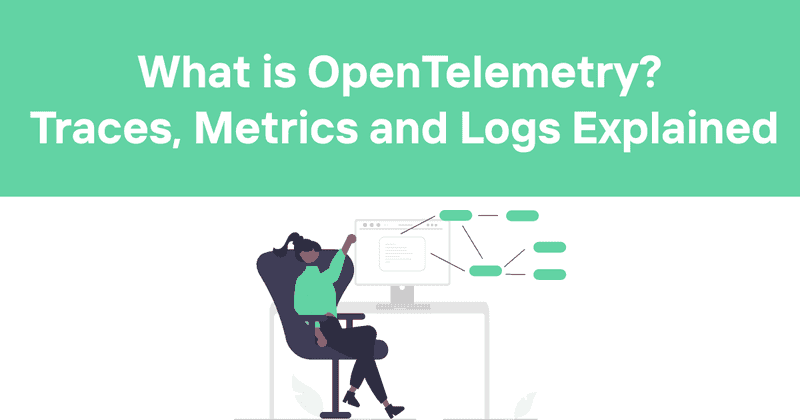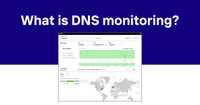What is OpenTelemetry? Traces, Metrics and Logs Explained
OpenTelemetry is a powerful observability framework designed to help developers instrument, generate, collect, and export telemetry data from their applications and infrastructure. This open-source project has rapidly become the industry standard for implementing observability in modern distributed systems and cloud-native applications.
Table of Contents
Understanding OpenTelemetry
OpenTelemetry emerged from the merger of two prominent open-source projects: OpenCensus (from Google) and OpenTracing (a Cloud Native Computing Foundation project). This consolidation happened in 2019, creating a unified, vendor-neutral approach to observability instrumentation.
At its core, OpenTelemetry solves a critical problem: it standardizes how we collect and transmit telemetry data in distributed systems. Before OpenTelemetry, developers faced vendor lock-in when choosing observability tools. Each monitoring solution required its own specific instrumentation approach, making it difficult to switch providers or use multiple tools simultaneously.
OpenTelemetry breaks this dependency by providing a single set of APIs, libraries, agents, and instrumentation that capture distributed traces, metrics, and logs from your applications. The data can then be exported to various backends of your choice for analysis.
The project is now an incubating project within the Cloud Native Computing Foundation (CNCF), with broad industry support. It's not just another monitoring tool—it's a standard for instrumenting code that's backed by major cloud providers and observability vendors.
The Core Components of OpenTelemetry
OpenTelemetry's architecture consists of several key components that work together to provide a complete observability solution:
APIs and SDKs
The OpenTelemetry APIs define how to instrument code, while the SDKs implement these APIs for different programming languages. Currently, OpenTelemetry supports multiple languages including Java, Python, Go, JavaScript, .NET, Ruby, PHP, Erlang, and C++.
These APIs provide a standardized way to:
- Create and manage spans for distributed tracing
- Record metrics
- Capture logs
- Add context to telemetry data
Collectors
The OpenTelemetry Collector is a vendor-agnostic implementation for receiving, processing, and exporting telemetry data. It serves as a single agent that can:
- Receive data in multiple formats (OTLP, Jaeger, Zipkin, Prometheus, etc.)
- Process and transform data with capabilities like filtering, batching, and attribution
- Export data to various backend systems
The collector comes in two deployment models:
- Agent: Runs alongside your application (as a sidecar or daemon)
- Gateway: Runs as a standalone service that receives data from multiple agents
Auto-instrumentation
One of OpenTelemetry's most powerful features is its ability to automatically instrument popular libraries and frameworks. This means you can often get valuable telemetry data with minimal code changes.
Auto-instrumentation typically works by:
- Intercepting method calls in common libraries
- Wrapping framework components
- Monitoring runtime metrics
While the level of support varies by language, most mainstream web frameworks, databases, and messaging systems have auto-instrumentation available.
Semantic Conventions
OpenTelemetry defines semantic conventions—standardized names and attributes for common concepts across different systems. These conventions ensure telemetry data is consistent and interoperable regardless of source.
For example, HTTP request spans always use the same attribute names (http.method, http.url, etc.), making it easier to correlate data across services and technologies.
OpenTelemetry Data Types
OpenTelemetry captures three main types of telemetry data:
Traces
Traces track the journey of requests across services in a distributed system. A trace consists of spans—discrete operations within the request flow.
Each span includes:
- Name and unique identifier
- Start and end timestamps
- Parent span reference (for nested operations)
- Key-value attributes with metadata
- Events with timestamps
- Links to related spans
Traces help developers understand request flows, dependencies, and bottlenecks in complex systems.
Metrics
Metrics are numeric measurements collected over time. OpenTelemetry supports several metric types:
- Counters: Cumulative values that only increase (e.g., request count)
- Gauges: Values that can increase or decrease (e.g., memory usage)
- Histograms: Distributions of measured values (e.g., request duration percentiles)
Metrics provide aggregate views of system behavior and performance, useful for monitoring, alerting, and capacity planning.
Logs
Logs are timestamped text records of discrete events. While OpenTelemetry initially focused on traces and metrics, the project now includes a logs specification that allows:
- Correlation of logs with traces and metrics
- Structured logging with consistent metadata
- Common export pipeline for all telemetry types
The integration of logs with traces and metrics creates a more complete observability solution, letting developers switch between different telemetry types when investigating issues.
How OpenTelemetry Works
The typical data flow in an OpenTelemetry-instrumented system follows these steps:
-
Instrumentation: Your code creates telemetry data using OpenTelemetry APIs, either manually or through auto-instrumentation.
-
Processing: The SDK processes this data by applying samplers, batch processors, and other configurations.
-
Export: Data is sent to the OpenTelemetry Collector or directly to a backend system.
-
Collection: If using the Collector, it receives data from multiple sources, processes it, and forwards it to your chosen backends.
-
Storage and Analysis: Backend systems store and visualize the data for monitoring and troubleshooting.
This architecture provides flexibility in how you collect and route telemetry data. You can start simple with direct export from your applications, then add collectors for advanced processing as your needs grow.
Context Propagation
A key aspect of OpenTelemetry is how it propagates context across service boundaries. This context typically includes:
- Trace identifiers
- Span identifiers
- Baggage (arbitrary key-value pairs)
When a service makes a request to another service, it includes this context in request headers. The receiving service extracts this context and uses it to correlate its telemetry with the upstream service.
OpenTelemetry supports multiple context propagation formats, including W3C TraceContext and Baggage, with the ability to add custom propagators.
Implementing OpenTelemetry
Integrating OpenTelemetry into your applications involves several steps:
Step 1: Choose Your Approach
You have three main options for instrumentation:
- Auto-instrumentation: Minimal code changes but less control
- Manual instrumentation: More work but more precise control
- Hybrid approach: Use auto-instrumentation as a base and add manual instrumentation for critical paths
The right choice depends on your requirements, resources, and existing codebase.
Step 2: Set Up the SDK
Install the OpenTelemetry SDK for your language and configure its components:
- Providers for traces, metrics, and logs
- Processors for batching and filtering
- Exporters for your backend systems
- Samplers to control data volume
Here's a simplified example in Java:
Step 3: Deploy the Collector
While optional, the OpenTelemetry Collector offers several advantages:
- Unified data pipeline
- Protocol translation
- Advanced processing
- Buffering and retries
A basic collector configuration in YAML might look like:
Step 4: Instrument Your Code
Apply auto-instrumentation or add manual spans to key parts of your code. For manual instrumentation, the pattern is typically:
- Start a span
- Set attributes
- Perform the operation
- End the span
Example in Python:
Step 5: Configure Sampling
As your system scales, you'll need to implement sampling to control telemetry volume. OpenTelemetry offers several sampling strategies:
- Always-on: Captures all data (good for development)
- Always-off: Captures no data (for emergency situations)
- Trace ID ratio: Samples a percentage of traces
- Parent-based: Uses the sampling decision from the parent span
- Rate limiting: Caps the number of samples per time period
Custom samplers can implement more complex logic based on trace attributes or system conditions.
OpenTelemetry vs. Other Observability Solutions
How does OpenTelemetry compare to other monitoring approaches?
OpenTelemetry vs. Vendor-Specific SDKs
Most observability vendors (Datadog, New Relic, Dynatrace, etc.) offer their own SDKs. Compared to these:
-
Vendor-specific SDKs:
- Pros: Optimized for specific backends, may have vendor-exclusive features
- Cons: Lock-in, inconsistent approaches across vendors, multiple agents required for multi-vendor setups
-
OpenTelemetry:
- Pros: Vendor-neutral, standardized approach, single instrumentation for multiple backends
- Cons: May lack some vendor-specific optimizations, still maturing in some areas
The trend is clear—many vendors now accept OpenTelemetry data directly and contribute to the project, recognizing its value as a standard.
OpenTelemetry vs. Other Open Standards
OpenTelemetry isn't the first open standard for telemetry:
- Prometheus focuses primarily on metrics with a pull-based model
- Zipkin and Jaeger pioneered distributed tracing standards
- Fluentd and Fluent Bit standardized log collection
OpenTelemetry incorporates lessons from all these projects while providing unified APIs that span all telemetry types. It doesn't replace these tools but offers consistent instrumentation that can work with them.
Use Cases and Benefits
Organizations adopt OpenTelemetry for several critical use cases:
Microservice Debugging
In distributed systems, a single user request might touch dozens of services. Traditional debugging breaks down in this environment.
OpenTelemetry traces show the complete request journey, making it possible to:
- Identify which service caused a failure
- Pinpoint performance bottlenecks
- Understand service dependencies
- Correlate errors across services
Performance Optimization
The metrics and traces from OpenTelemetry help teams optimize performance by:
- Establishing performance baselines
- Identifying slow components and requests
- Measuring the impact of optimizations
- Detecting performance regressions
A common pattern is using traces to find problematic request patterns, then setting up metrics to monitor these patterns continuously.
Multi-Cloud Observability
For organizations running workloads across multiple cloud providers, OpenTelemetry offers consistent instrumentation regardless of environment. This allows:
- Unified monitoring across clouds
- Consistent context propagation
- Common visualization and alerting
Vendor Flexibility
Perhaps the biggest benefit is avoiding vendor lock-in. With OpenTelemetry:
- Switching observability vendors becomes a configuration change, not a re-instrumentation project
- Using multiple specialized tools for different telemetry types becomes feasible
- Testing new monitoring solutions alongside existing ones is straightforward
Cost Control
OpenTelemetry's sampling and filtering capabilities help control observability costs by:
- Reducing data volume through intelligent sampling
- Filtering out low-value telemetry
- Consolidating agents and collectors
Common Challenges and Solutions
Implementing OpenTelemetry isn't without challenges. Here are some common issues and how to address them:
Data Volume Management
Challenge: Telemetry data can grow explosively, increasing costs and overwhelming backends.
Solutions:
- Implement head-based sampling for high-volume services
- Use tail-based sampling in collectors for more intelligent filtering
- Configure attribute filtering to reduce cardinality
- Start with critical services rather than instrumenting everything at once
Deployment Complexity
Challenge: Adding instrumentation to every service and managing collectors can be complex.
Solutions:
- Use auto-instrumentation where possible
- Deploy collectors as sidecars or per-node daemons
- Leverage service meshes for automatic context propagation
- Implement progressive instrumentation, starting with critical paths
Context Propagation Gaps
Challenge: Missing context between services breaks trace continuity.
Solutions:
- Standardize on W3C TraceContext headers across all services
- Use middleware for automatic header propagation
- Implement bridge propagators for legacy systems
- Test trace continuity across service boundaries
Maturity Concerns
Challenge: Some parts of OpenTelemetry are still evolving, particularly logs integration.
Solutions:
- Follow the stability guidance in the OpenTelemetry documentation
- Start with the most stable components (traces, then metrics)
- Join the community to stay informed about changes
- Consider vendor distributions that provide additional stability guarantees
The Future of OpenTelemetry
OpenTelemetry continues to evolve rapidly. Key trends to watch:
Continuous Improvement in Instrumentation
The project consistently expands auto-instrumentation coverage for frameworks and libraries. This means developers can expect:
- More out-of-the-box visibility
- Less manual instrumentation work
- Better coverage of edge cases
Advanced Sampling Techniques
The community is developing more sophisticated sampling approaches:
- Adaptive sampling based on system conditions
- ML-driven sampling that learns what's important
- Context-aware sampling that considers business value
Enhanced Profiling Integration
Profiling—collecting detailed execution data—is becoming a fourth pillar of observability alongside traces, metrics, and logs. OpenTelemetry is exploring integrations with profiling tools to provide deeper performance insights.
Unified Logs Pipeline
As the logs specification matures, expect tighter integration between logs and other telemetry types, making it easier to correlate all observability data.
eBPF Integration
Extended Berkeley Packet Filter (eBPF) technology enables kernel-level tracing with minimal overhead. OpenTelemetry projects are beginning to leverage eBPF for:
- Zero-code instrumentation
- Kernel-level visibility
- Lower overhead collection
How Odown Complements OpenTelemetry
While OpenTelemetry provides deep internal observability for your applications, Odown offers complementary external monitoring capabilities that complete your observability strategy.
External Verification
OpenTelemetry gives you visibility into your application's internal behavior, but it doesn't tell you how users experience your services from the outside. Odown provides this external perspective through:
- Regular uptime checks from multiple global locations
- Real-time alerts when services become unavailable
- Historical uptime analytics to track reliability over time
This external verification validates that your systems are not just running but actually accessible to users—something internal monitoring alone can't confirm.
SSL Certificate Monitoring
OpenTelemetry can track many aspects of your application health, but SSL certificate management remains a critical blind spot for many organizations. Odown fills this gap with dedicated SSL monitoring that:
- Tracks certificate expiration dates
- Monitors for certificate validity issues
- Alerts you before certificates expire
- Verifies proper certificate configuration
Certificate failures can render your services inaccessible even when they're running perfectly—making this monitoring complementary to your OpenTelemetry implementation.
Public Status Pages
When incidents do occur, communicating with users becomes just as important as resolving the technical issues. Odown's public status pages integrate with your monitoring data to:
- Automatically publish service status information
- Provide transparent incident communication
- Display historical uptime metrics
- Build trust through proactive communication
This creates a complete observability loop where internal telemetry drives technical responses while external monitoring informs user communication.
Unified Monitoring Strategy
The most effective monitoring strategies combine:
- Deep internal observability (OpenTelemetry)
- External verification (Odown uptime monitoring)
- Security monitoring (Odown SSL certificate checks)
- User communication (Odown status pages)
This comprehensive approach ensures you have both the technical data needed to maintain reliable services and the communication tools to build user trust.
By implementing OpenTelemetry alongside Odown's monitoring capabilities, you create a complete observability solution that addresses both the technical and communication aspects of modern service reliability.



